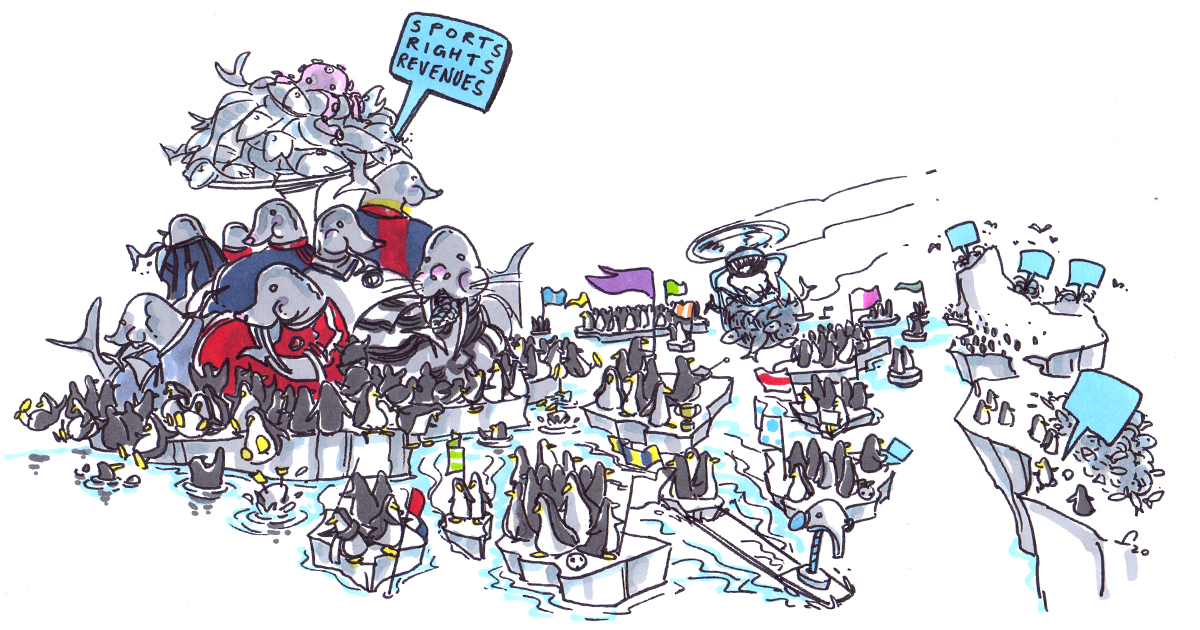Well, the unbundling of sports leagues had already started, before Covid19, hadn’t it?
The best way to have observed that, was in the polarisation and resentments in the English Football League (EFL) or, indeed, any sports league in Europe. Arguments about money and governance everywhere.
In very summary form the issue is this: bigger clubs are fed up subsidising smaller clubs in a form of trickle-down economics, when tech and direct distribution allows people to very clearly see what drives engagement and value.
Sport content businesses, from ESPN, Sky Sports, to digital publishers, podcasts, and national newspapers now know what works. It’s the big clubs and big players that are of interest to a mass market.
This tsunami of inevitability has only really been accelerated by Covid19. It was coming, as sports pay-tv channels were already dramatically disinvesting from 2nd/3rd/4th tier rights.
So now, when money is tighter in sports, there is simply less acceptance of the “distribution to the family of football model”. We can’t and shouldn’t sugar coat this.
Smaller sports clubs,
based around a community,
will need to make the business sustainable themselves,
and should get ready to rely less on the waterfall of sports rights revenues. They will stop.
This is a theme that we, at Are You Not Entertained?, have flagged for 2 years and, recently, with our episodes around “is sport investable?” (Season 2, episode 43 – episode 44). Indeed, this article is prompted by former podcast guest, Simon Hallett, owner and Chairman of Plymouth Argyle.
Lower league football/sports clubs like Plymouth are not just businesses; they are the fabric of a community and they play an essential role. Anyone who watched the Netflix series “The English game” will know exactly what I mean. They are important still to this day.
So how to give them a sustainable future?
Albachiara works extensively with sporttech companies looking at new models, like Pixellot (low cost AI sports production), so we deal with these conundrums every day. Let’s take them in turn.
- Revenues from covering games for broadcast
- Revenues from a local and loyal fanbase, including matchday
- Revenues from player sales
- Costs of the playing side
- Costs of the club operations
- The real estate play
1. Revenues from broadcast
In the old world, this was the trickle-down distribution from central league contracts. Where smaller clubs “earned” more than their worth. We are arguing that this will end, to a greater or lesser degree.
Going forward, clubs will “eat what they kill”.
So, can clubs profitably cover their own games whilst not cannibalising match day fans at the stadium? To date, sports broadcast production has been expensive, and frankly, not worth the candle for smaller teams.
These costs of production have reduced significantly with AI broadcast technology.
Disclosure: we act for Pixellot, the leader in this field.
But is that cost saving enough?
How does a small club potentially monetise this investment?
- D2C digital season tickets domestically (let’s assume the 3pm Saturday closed period is removed) and internationally.
- Watch and Bet revenues for the game footage from a company like Sportsradar, IMG Arena or Genius.
- Sponsorship of the Pixellot kit by a farsighted brand.
- Ad revenues from social media broadcasting.
- Sale to a local broadcaster.
Experience shows that all of these revenue streams are significantly more challenged than the Kool Aid theory around. There aren’t that many hardcore fans. Watch and Bet depends on the timing of the games. Sponsors want rich fan data that sport clubs aren’t set up to deliver, etc. For further discussion on these themes, tune into the Groundsmen!
2. Revenues from local fanbase and matchday
All sports clubs have an issue with GenZ. These kids just aren’t interested in an entertainment offering of journeyman quality football.
A small club just can’t market on athlete excellence, but only on some sense of “fandom” and community. And leveraging the sense of belonging.
This is the core competence of Giles Morgan and his crusade for deep fan engagement via 1st person data. Community clubs will have to get very good at this, both physical and digital, to have any chance of survival. They have a limited fanbase, where their task is to increase that ARPU. It can be done, but not with sports’ clubs current skillset.
3. Revenues from player sales
This has been, indeed, the Hail Mary Pass Strategy for most clubs. For many it has worked, mainly due simply to astonishing player inflation in recent years. As we enter deflation in player valuations, this income stream will dry up to the point that it is to be considered only as an occasional bonus for a club. A premium bond win if you will. You don’t agree? Think also that many clubs will have learnt the costly lessons of overhead inflexibility that comes with multi-year player contracts. They will now adapt to short term contracts and lower base wages.
The gig economy will come to football also.
In these circumstances, transfer fees will become rare.
4. Costs of the playing side
As mentioned above, there will be a premium on flexibility and performance-based pay. There will also be an increasing use of data to minimise mistakes, maximise value-for-money, and prevent injuries. The days of the powerful manager will therefore be over. Community clubs will instead have coaches, not all-powerful Shanklys and Fergusons.
It seems obvious, when you use the adjective “community”, that these clubs must seek to have at least half the first team from the local catchment area and academy. Players will get blooded at 17/18. This will enhance the intangible sense of belonging among fans and the town.
All fine in theory, until you introduce the sirens songs of promotion and relegation. That will, in fact, separate the wheat from the chaff. Discipline and process. No decision made on short term passion impulses. The acid test!
5. Costs of club operations
Inevitably, intelligent club owners will realise that many of these skills in fan engagement, content, data, CRM etc are skills that can be outsourced. And they will be. Likely to a central shared sports services operator capturing economies of scale. Watch out for that one.
6. The real estate play
Always a factor, now a cornerstone consideration, in assessing if a local community club can be sustainable. Those assets need to be sweated and directed towards increasing the ARPU. Not new thinking. Just now front and centre.
In conclusion, without the subsidies from being part of leagues with box office clubs, much of community football in the professional leagues will need to make radical changes to even be around in 12 months. I refer you back to Simon Hallett’s letter: “this is the last money I will put in”.
The tide is out. Let’s see who has been swimming naked.
To find out what we do in change management, see here.
For our C-suite management services, read here.
And here you find our content development service.
To understand which type of professional training we deliver, discover our Corporate Learning programmes.
If you are interested in our story, check us out here.



